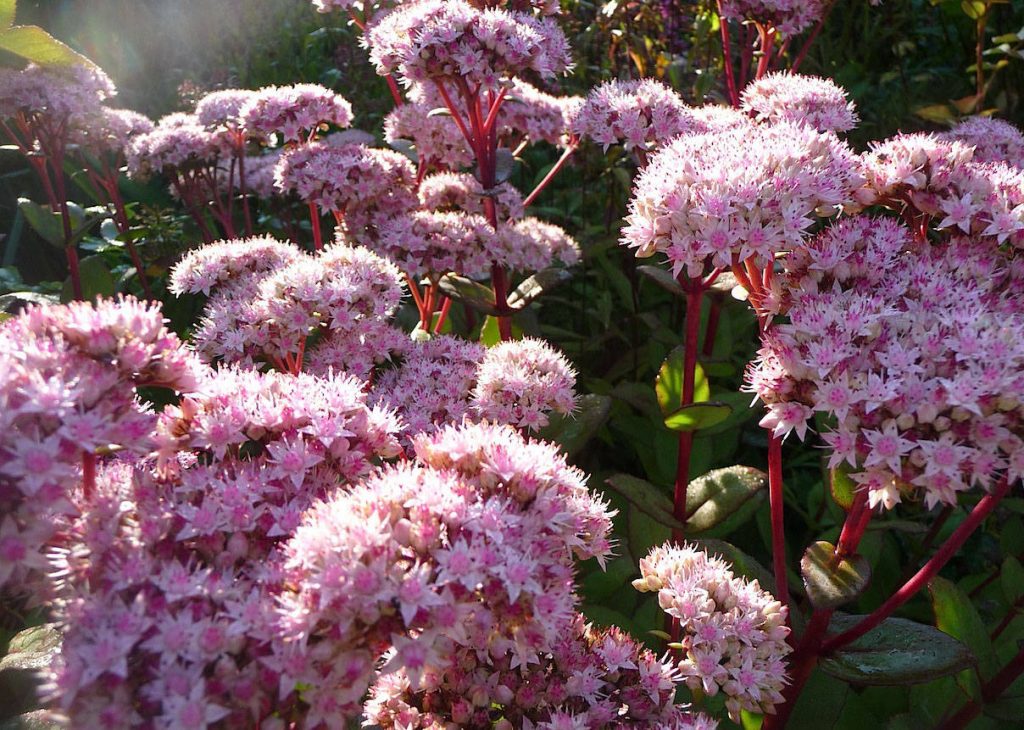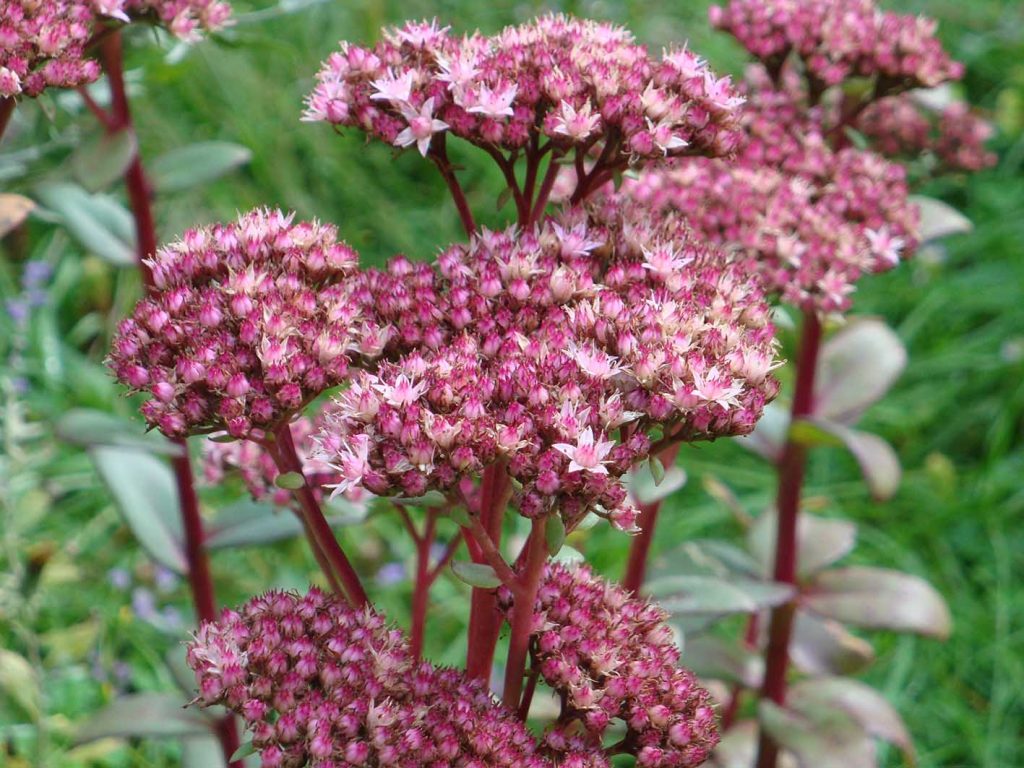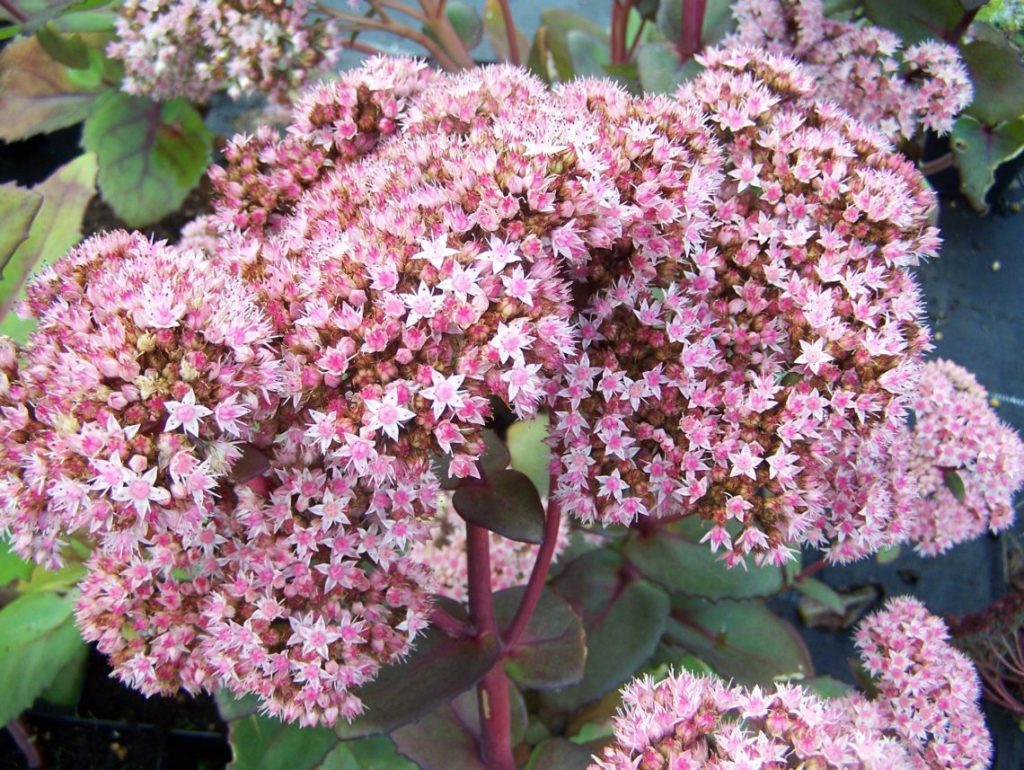Sedum Matrona - detailed characteristics of the plant
Sedum, or sedum Matrona, is a pretty ornamental plant that blooms until the very cold. Due to its unpretentiousness and long flowering, it is in demand in landscape design. Telephiums are widespread in Europe and the East, but this particular species comes from China.

Sedum matron photo
Characteristic
Sedum matrona (Sedum telephium Matrona) is a herbaceous perennial shrub, reaching a height of 50-60 cm.
- The bush is compact and dense, with free-standing reddish stems.
- The leaves are oval, green in color (in some hybrid forms, they are brownish-burgundy).
- Flowers are small, pink, collected in thyroid inflorescences with a diameter of 10-15 cm.
- The root system is horizontally branched.
The plant belongs to succulents, therefore it has the ability to accumulate moisture in tissues. It successfully tolerates drought and is not afraid of cold weather.
With proper care and favorable growing conditions, it is resistant to pests and diseases.
Purchase and adaptation
Planting sedum is usually purchased in a container. Be careful - there should be no foreign spots, dry and damaged stems.
Do not immediately plant the plant on the site: watch for a week or two to see if signs of disease appear.
Place the pot in the yard so that the sedum adapts to the new conditions, and then transplant.
Landing rules
Matrona, growing in a sunny area, is very decorative with lush and bright inflorescences. It can be planted in partial shade, but in full shade the bush grows weak and pale. Sedum is not picky about the soil. The best option would be loam or sandy loam. In heavy, dense soils, you can add a little sand.

Sedum matron landing and leaving
Technology:
- At the beginning of May, the land on the site is dug up, while removing the weeds.
- At a distance of half a meter, holes are dug 15 cm deep.
- Humus and a handful of ash are placed in the pits.
- The plants are removed from the container along with the earthen clod and the holes are placed.
- Each seedling is watered abundantly with lukewarm water and covered with earth, tamping well.
Growing conditions
Sedum prefers dry air or moderate humidity and does not require additional spraying. Waterlogging of the soil can provoke root rot, therefore, drainage is laid in areas with stagnant water during planting. For good growth, Matrona needs bright lighting or light partial shade.
The plant tolerates temperatures up to 30 ° C, but feels better at 20-25 ° C. Flowering continues until mid-autumn and longer, while the flowers are not afraid of temporary cold snaps and even frosts (up to -5 ° C). For the winter, it is better to cover the bushes with humus, after cutting off the stems with inflorescences.
Care
Growing Sedum is easy. This is an unpretentious plant that adequately tolerates weather changes.However, simple care will improve the decorative effect of the shrub and create excellent disease prevention.
Watering
Watering is needed only immediately after planting, as well as during long dry periods. With regular precipitation, they are not necessary.
Watered with settled water strictly at the root. At the end of winter, you can shower dust and dirt from the bushes with a shower.
Loosening and weeding
As necessary, the soil next to the bushes is weeded and loosened. The procedure improves the access of oxygen, water and nutrients to the roots. In addition, weeding creates a natural prevention of pests and diseases.

Sedum matrona
Top dressing
When planting a shrub, organic matter is laid in the soil - this will be enough for him until winter. Before wintering, the bushes are covered with humus, which provides not only warmth, but also a future reserve of nutrients. Sedum does not need additional feeding.
It is important not to overfeed with nitrogen (or organic fertilizers) to avoid powdery mildew.
Pruning and replanting
Sedums are pruned after flowering, which lasts from July to mid-October. Cutting the peduncles is necessary to preserve the decorative effect. The transplant is carried out after 5-6 years, dividing the bushes or renewing by cuttings.
Reproduction
Most often, sedum is propagated by cuttings or dividing the bush. Cuttings can be rooted in spring, summer, or after pruning before winter. In the latter case, the inflorescences are removed on the shoots cut in the fall and immersed in water.
After a few weeks, the process of root formation begins. When the roots grow enough, the cuttings are deepened into containers with a sandy substrate, and in May they are transplanted to a permanent place.
In the second method of reproduction, the Sedum bush is divided into three parts and planted (each of them should have young growth and approximately equal volume of roots).
In landscape design
Sedum is widely used in landscape design due to long flowering, resistance to heat and cold, unpretentiousness to soils, spectacular appearance.

Sedum matron in landscape design photo
If ordinary varieties are planted to cover up some flaws, then Matrona can serve as an ornament in itself. It is successfully combined with other telephiums, as well as with cereals, blue spruce, pine, junipers.
Sedum is often planted next to stones, in rockeries, on alpine hills. It will be an excellent border separating two garden areas. Bright bushes look great along the paths, ideally decorate fences and walls of private houses.
Low-growing varieties are used as ground covers, creating colorful lawns and carpet beds.
With a lack of planting land, Matrona can be grown directly in a container.
Diseases and pests
| Problem | Symptoms | Prevention measures | Treatment methods |
| Mealybug | White cotton-like bloom on the leaves, oblong centipede insects. | Adhere to quarantine for new plants before moving them into the garden. Cut dry and damaged shoots in time, remove fallen leaves. | Wash the bush with a solution of laundry soap; Treat with special preparations (Admiral, Confidor, Fitoverm). |
| Aphid | Small light green bugs appear; the leaves curl and dry up. | Same as for mealybug. Additionally - attraction of birds to the site (natural exterminators of insects). | Washing with celandine or soap-alcohol solution. Spraying with insecticides (Decis, Spark, Karate.) |
| Spider mite | Brown spots and light yellow spots. A cobweb may appear on the bottom of the sheet. | Timely weeding, removal of fallen leaves. In places of stagnant water during planting, drainage must be laid. | Treat with acaricide preparations (Vermitek, Neoron, Flumite). |
| Root rot | The bush slows down in growth, the leaves wither and fall off, the stems darken and become thinner. | Disinfection of seeds, soil, garden tools. | At the first stage, you can use biological products like Glyocadin; in the later stages, transplant the shrub by cutting off the affected parts and treating with copper sulfate. |
| Powdery mildew | White bloom, small dark tubercles. Infected leaves dry out. | Do not thicken the planting, do not overfeed with organic matter and nitrogen fertilizers | At the first signs of the disease, apply fungicides (Vectra, Cumulus, Topaz, Skor, Amistar). |

